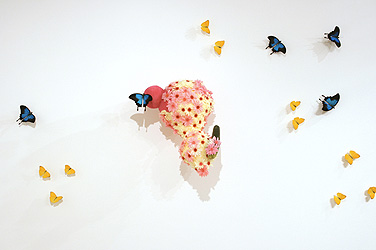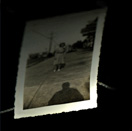News
Exhibitions to open in UB Art Gallery

Roberley Bell, Flutter #3, 2008, cast foam forms, plastic preserved butterflies. From “Figuration and its Disconnects.” Photo: COURTESY UB ART GALLERY
-
 Print
Print -
 Comments
Comments
-

Two exhibitions—one of contemporary still life and figuration, the other selections from Department of Visual Studies students’ 2010 senior theses—will open on Feb. 17 in the UB Art Gallery in the Center for the Arts, North Campus.
“Figuration and its Disconnects” is a play on Sigmund Freud’s canonical book “Civilization and Its Discontents” (1929), which examines the interplay between society and the individual, whose instinctual desires for aggression and sex threaten to destabilize societal relations. It will be on display through May 14 in the First Floor Gallery.
“Noncommittal: A Prospective Glance 3,” a group exhibition featuring the work of recent Visual Studies graduates Erik Baker, Stephanie Carosa and Jamie Major, will be on view through March 12 in the Second Floor Gallery.
Both exhibitions are free and open to the public. Opening receptions will be held from 5-7 p.m. Feb. 17.
The 20th century bore witness to the upheavals of continuous war, the Space Age, the Civil Rights’ and Women’s movements, decolonization, ecological devastation and the rise of mass media. “Figuration and its Disconnects” explores how we relate to each other, and even inanimate objects, in such a world.
The exhibition pairs work from the university’s permanent collection by Bruce Adams, Leon Golub, Libby Hague, Lester Johnson and William Scott with work by Western New York-based artists James A. Allen, Roberley Bell, Amanda Besl, Jonathan Daly, Andrew Engl, Jackie Felix, Richard Huntington, Joan Linder, Nathan Naetzker, Kurt Von Voetsch and Adam Weekly that includes drawings, paintings and an immersive installation.
These artists’ representations of people and things comment on the authority, seduction, miscommunication, powerlessness, happiness, whimsy and alienation that arguably define our communal existence. A man asleep next to a corded phone; expertly tied ropes suggesting the contours and weight of an absent body; sunlit young women on the cusp of adulthood; frieze-like giants dancing in city streets; and a dead starling set against a fuchsia background are just a few of the images, impregnated with the violence and pleasure of their lived realities, that viewers will encounter in this exhibition.
“Noncommittal” is a collaboration between the UB Art Galleries and the Department of Visual Studies.
Spending most weekends at his father’s secluded rural home, Erik Baker amused himself by exercising his imagination and construction skills. Tinkering with an erector set or crafting something from scrap parts in his workshop were not uncommon activities. For this exhibition, Baker has constructed Buffalo BrewBot, a fully functional, multifaceted and interactive custom beer-bottling machine.
Based on user input, this semi-automated structure mixes custom, home-brewed beer by adding user-selected ingredients and supplements. The machine will operate during the opening reception and provide beer for those 21 years or older.
The Buffalo BrewBot satisfies consumer demand for a custom, personalized beverage, while also providing a visually entertaining demonstration of the mechanical, electrical and robotic ingenuity that makes it possible.
Stephanie Carosa’s darkly expressionistic paintings are informed by her interest in sociology and human behavior. Fascinated by how the mind works, she mines the psychological underpinnings of the irrational behavior and paranoia exhibited by individuals swept up in mass hysteria. In her humorous portrayal of the recent H1N1 strain of influenza—also known as swine flu—for instance, she explores how humans react to fear by depicting pig-children gleefully dancing. In another painting, “Are We Sterile Yet” (2010), a man emerges from a pitch-black background, desperately clutching a mask to his face in an updated take on Edvard Munch’s “The Scream” (1893).
A family of four is seen posing for the camera. A woman walking down the street is about to be engulfed by a hulking shadow. Working with photographs one might find in an antique shop, Jamie Major distorts these prosaic images by blurring the scenes and faces while keeping other details in focus. Major scanned these vintage photographs and represented them at angle, as if they were freefalling into space. A delicately braided rope is attached to each, alluding to the precarious grip that people who look at photographs have on their memories. Viewers are encouraged to establish a rapport with these anonymous photographs—either by directly identifying with them or fabricating fictions.
The UB Art Gallery in the Center for the Arts is open from 11 a.m. to 5 p.m. Tuesday through Saturday.

Reader Comments